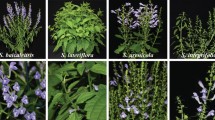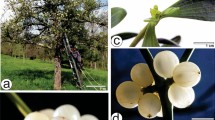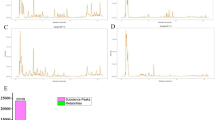Abstract
Although the ancient Briton's woad, from Isatis tinctorio L., has been differentiated from the indigo dye indoxyl-β-D-glucoside, from the tropical legume genus Indigofera, it has never been identified. It has now been shown to be indoxyl-5-ketogluconate and its structure is completely specified.
This is a preview of subscription content, access via your institution
Access options
Subscribe to this journal
Receive 51 print issues and online access
$199.00 per year
only $3.90 per issue
Buy this article
- Purchase on Springer Link
- Instant access to full article PDF
Prices may be subject to local taxes which are calculated during checkout
Similar content being viewed by others
References
Hurry, J. B., in The Woad Plant and its Dye, 328 (Oxford Univ. Press, 1930).
Sachs, J. H., in Encyclopaedia Britannica, 10, 256 (1963).
Dictionary of Organic Compounds, 3, 1845 (Oxford Univ. Press, 1965).
Karrer, W., in Konstitution und Vorkommen der organischen Pflanzenstoffe, 1035 (Birkhauser Verlag, Basel, 1958).
Robinson, T., in The Organic Constituents of Higher Plants, 292 (Burgess Publishing Co., Minneapolis, Minn., 1963).
Schunck, E., Phil. Mag., Ser. 4, 10, 73 (1855); ibid., 15, 29, 117, 183 (1858).
Schunck, E., Chem. News, 39, 119, 129, 143 (1879).
Hoogewerf, S., and ter Meulen, H., Proc. Koninkl. Ned. Akad. Wetenschap., 2, 520 (1900).
Schunck, E., Chem. News, 82, 176 (1900).
Beijerinck, M. W., Proc. Koninkl. Ned. Akad. Wetenschap., 2, 120 (1900); ibid., 3, 101 (1901).
Perkin, A. G., and Bloxam, W. P., J. Chem. Soc., 91, 1715 (1907).
Laurent, A., Rev. Sci. Indust., 10, 289 (1842).
Lefèvre, L., Bull. Soc. Chim., 19, 113 (1916).
Hansen, C. W., Ann. Chim. (10), 1, 94 (1924).
Sander, L., Chem. Ber., 58, 820 (1925).
Wahl, A., and Hansen, W., C.R. Acad. Sci, 178, 393 (1924).
Stowe, B. B., Fortschr. Chem. org. Naturstoffe, 17, 248 (1959).
Gmelin, R., and Virtanen, A. I., Ann. Acad. Sci., Fennicae No. 107, 25 (1961).
Kutáček, M., and Procházka, Ž., in Regulateurs Naturels de la Croissance Végétale, Colloq. Intern. Centre Nat. Recherche Sci. (Paris), No. 123, 445 (1964).
Bingham, H., in Elihu Yale, 362 (Dodd Mead and Co., New York, 1939).
Obreiter, J. B., and Stowe, B. B., J. Chromatog., 16, 226 (1964).
Perley, J. E., and Stowe, B. B., Biochem. J., 100, 169 (1966).
Smith, I., in Chromatographic and Electrophoretic Techniques, 1, 197 (Wm. Heinemann Ltd., London, 1960).
Barch, W. E., J. Amer. Chem. Soc., 55, 3653 (1933).
Bevenue, A., and Williams, K. T., Arch. Biochem. Biophys., 71, 477 (1957).
Fewster, J. A., Biochem. J., 69, 582 (1958).
Hais, I. M., and Macek, K., in Paper Chromatography, A Comprehensive Treatise (Czechoslovak Acad Sci., Prague, and Academic Press, New York, 1963).
Dawson, D. M. C., Elliott, D. C., Elliott, W. H., and Jones, K. M., in Data for Biochemical Research, 238 (Oxford Univ. Press, 1959).
Ruff, O., Chem. Ber., 32, 2270 (1899).
Schramm, M., Anal. Chem., 28, 963 (1956).
Berkeley, C., Nature, 191, 1414 (1961).
Finkle, B. J., Kelly, S., and Loewus, F. A., Biochim. Biophys. Acta, 38, 332 (1960).
Isherwood, F. A., and Mapson, L. W., Ann. Rev. Plant Physiol., 13, 329 (1962).
Franjo, M. F., Farm. Glasnik, 6, 1 (1950).
Hadders, M., in Handbuch der Pflanzenanalyse (edit. by Klein, G.), 3 (2), 1062 (J. Springer, Wien, 1932).
Author information
Authors and Affiliations
Rights and permissions
About this article
Cite this article
EPSTEIN, E., NABORS, M. & STOWE, B. Origin of Indigo of Woad. Nature 216, 547–549 (1967). https://doi.org/10.1038/216547a0
Received:
Published:
Issue Date:
DOI: https://doi.org/10.1038/216547a0
This article is cited by
-
Transcriptome Analysis of Nitrogen Metabolism, Transcription Factors, and Indigoid Biosynthesis in Isatis indigotica Fort. Response to Nitrogen Availability
Journal of Plant Growth Regulation (2021)
-
Effect of different physico-chemical parameters for natural indigo production during fermentation of Indigofera plant biomass
3 Biotech (2017)
-
Identification of natural indigo in historical textiles by GC–MS
Analytical and Bioanalytical Chemistry (2015)
-
Genetic diversity in populations of Isatis glauca Aucher ex Boiss. ssp. from Central Anatolia in Turkey, as revealed by AFLP analysis
Botanical Studies (2013)
-
Production and characterization of intertribal somatic hybrids of Raphanus sativus and Brassica rapa with dye and medicinal plant Isatis indigotica
Plant Cell Reports (2008)
Comments
By submitting a comment you agree to abide by our Terms and Community Guidelines. If you find something abusive or that does not comply with our terms or guidelines please flag it as inappropriate.



